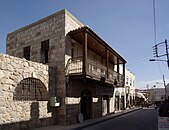Madaba (Arabic مادبا) is one of the governorates of Jordan. It is located southwest of Amman, the capital of Jordan, and its capital is Madaba. The governorate is ranked 8th (of 12 governorates) by population and area. It is bordered by Balqa Governorate to the north, The Capital Governorate to the east, Karak Governorate to the south and the Dead Sea to the west.
History

The region has been occupied over the centuries by Moabites, Nabateans, Romans, and Arab Muslim empires.
Madaba is known for its Byzantine and Umayyad mosaics, especially the Madaba Map, a large Byzantine-era mosaic map of Palestine and the Nile delta.
Biblical and antiquity
In the Bible, Mount Nebo is the site where Moses viewed the Land of Israel. Just west of Madaba city, Mount Nebo formed part of the Madaba Diocese in Byzantine times. The mosaics discovered in the village of Nebo, in the 'Uyun Musa valley and Ayn al-Kanisah carry inscriptions which date them to the times of the Bishops of Madaba from the late fifth century to the middle of the eighth century.
Um er-Rasas (Kastron Mefaa) lying on the southeastern steppes, also formed part of the diocese, close to Wadi Mujib (Arnon river), a natural boundary of the Province. The mosaics of the Saint Stephen Complex and Church of the Lions (sixth-eighth centuries AD) were found here in addition to an eighth-century mosaic in the village of Ma'in.
Mukawer 15 km south of Madaba city, is where the body of Saint John the Baptist supposedly lies after he was beheaded at the request of King Herod Antipas' niece. The site is located on top of a mountain rising from the shores of the Dead Sea and overlooking the Dead Sea and ancient Israel.
The Madaba Map is the only complete mosaic map of Jerusalem from the Byzantine era.
Many archeological excavations with pre-Biblical and Biblical emphases take part during the summer months in Madaba Governorate; new discoveries are being made each year.
Geography
Madaba Governorate is bordered by Capital Governorate from the east and Balqa Governorate from the north, the West Bank across the Jordan River, and the Dead Sea from the west, and Karak Governorate from the south. Ma'in is the site of a natural thermal waterfall. Its therapeutic effects are sought as a cure for aching joints and skin irritations.
The climate range is wide due to differences in altitude. The capital city of Madaba is 798 meters above sea level, while the Dead Sea is at about 300 meters below sea level, resulting in a double digit difference in temperature between the two locations.
Economy
Tourism
Due to its historic sites and natural attractions, including the Ma'in Hot Springs and the Dead Sea, tourism is the main source of income. The governorate is the fifth touristic destination following Petra, Jerash, Aqaba, and Amman.
Agriculture
The northern region of the governorate is agricultural, with a total area of 59 km2 of fruit and olive farms. The governorates production of olives and fruits is eighth on the kingdom (after Balqa, Irbid, Mafraq, The Capital, Ajloun, Jerash, and Zarqa governorates).[2]
Administrative divisions

Article 12 of the Administrative Divisions law of the Jordanian Ministry of Interior divides Madaba into two departments:
- Capital Department: with its administrative center in the city of Madaba, this department also includes 26 other towns and villages.
- Dhiban Department: Includes 44 towns and villages, with its administrative center in Dhiban
Demographics
The population of districts according to census results:[3]
| District | Population (Census 1994) |
Population (Census 2004) |
Population (Census 2015) |
|---|---|---|---|
| Madaba Governorate | 107,321 | 129,960 | 189,192 |
| Dhībān | 23,497 | 28,577 | 36,422 |
| Qaṣabah Ma'dabā | 83,824 | 101,383 | 152,770 |
Gallery
-
The brass serpent sculpture on Mount Nebo
-
The Dead Sea from the Kempinski Hotel in Madaba Governorate
-
The Dead Sea beach in Madaba Governorate
-
An old neighborhood in Madaba
References
- ^ "Sub-national HDI - Area Database - Global Data Lab". hdi.globaldatalab.org. Retrieved 2018-09-13.
- ^ "Ministry of Agriculture- Jordan (Arabic site)". Archived from the original on 2012-03-03. Retrieved 2010-01-30.
- ^ "Jordan: Administrative Division, Governorates and Districts". citypopulation.de. Retrieved 25 December 2016.















You must be logged in to post a comment.